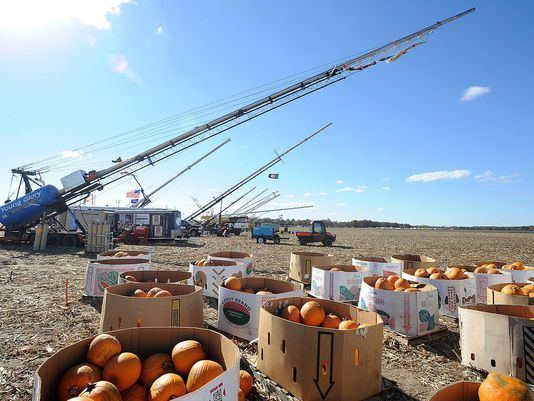 | ||
Pumpkin chucking final
Pumpkin chucking, or for rhyming purposes Punkin Chunkin and Pumpkin Chunking, is the sport of hurling or 'chucking' a pumpkin solely by mechanical means for distance. The devices used include slingshots, catapults, centrifugals, trebuchets, and pneumatic cannons.
Contents
- Pumpkin chucking final
- World Championship Punkin Chunkin
- Television coverage
- World Championship Punkin Chunkin records
- References
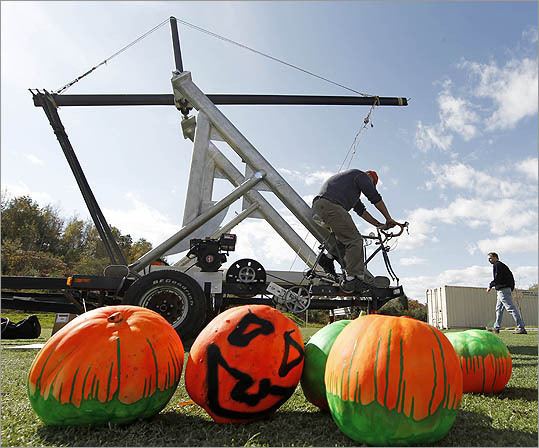
Pumpkin chucking competitions, formal and informal, exist throughout the United States in the autumn, and often occur when pumpkins are harvested. World Championship Punkin Chunkin, held annually in November in Delaware by the World Championship Punkin Chunkin Association (WCPCA), was the first and largest annual competition. The event began in 1986, and in 2010 featured over 100 teams, but in 2014 and 2015 it was not held due to logistical problems and its future is uncertain. A European Championship has been held in Bikschote, Belgium each year since 2004.
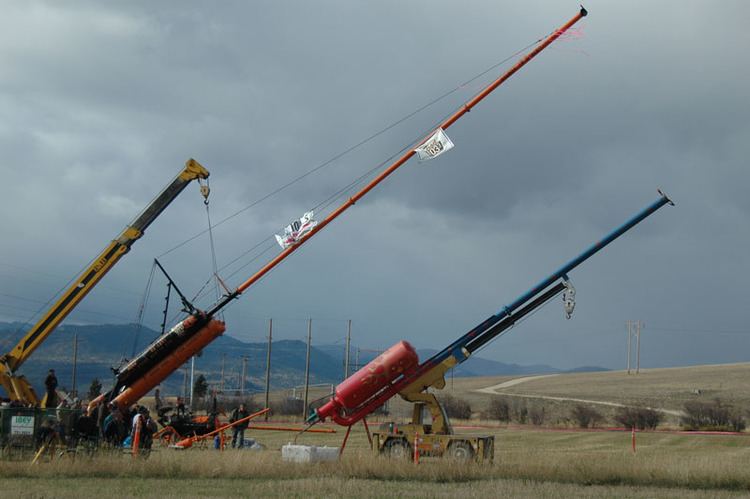
The Guinness world record shot is held by a pneumatic cannon dubbed "Big 10 Inch", at 5,545.43 feet (1,690.25 m), on September 9, 2010 in Moab, Utah. The shot received certification from Guinness World Records in early February 2011. It has also competed many times at the WCPC event in Delaware. The WCPCA World Record, which includes only shots made at the annual World Championship event, is held by Team American Chunker, captained by Brian Labrie of New Hampshire, at 4,694.68 feet (1,430.94 m) on November 1, 2013, in Bridgeville, Delaware, the longest shot in event history. The difference in results between Delaware and Utah could be due to the higher, thinner, drier air found in Utah providing less resistance and drag, thus greater range.
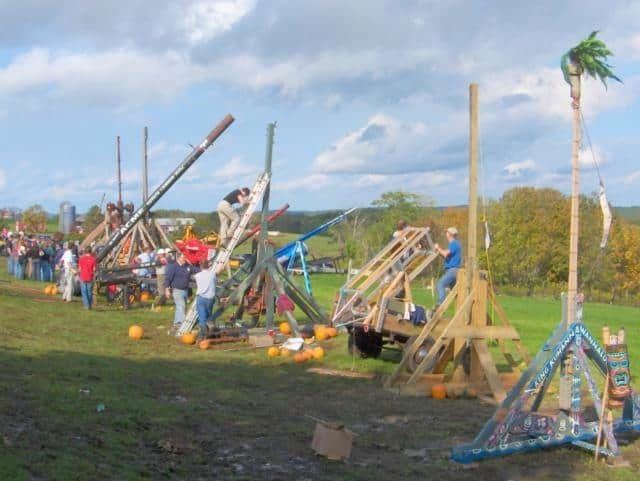
The range achieved by devices greatly depends on their mass, shape, and size; the yield limits, stiffness, pitch, and elevation of the hurler; and the weather. The pumpkin is another important variable since sabots are often prohibited in competitions. The most common pumpkin varieties used are Caspers, Luminas, and La Estrellas – these varieties typically have thicker rinds and can better withstand the forces of launch. One of the core rules for competition is that the pumpkin must remain whole after leaving the device until hitting the ground for the chunk to count. Pumpkins that burst after leaving the barrel or sling — resulting in the "shot" being disqualified in the WCPC rules — are referred to as "pie" (short for "pumpkin pie in the sky").
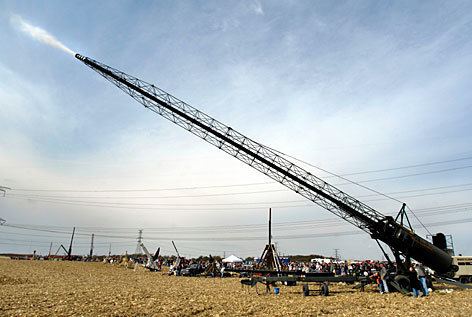
World Championship Punkin Chunkin
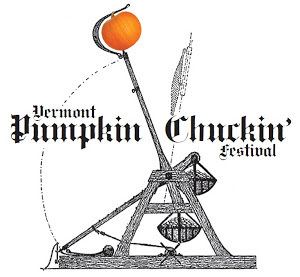
World Championship Punkin Chunkin (WCPC) was the name of an annual contest held the first full weekend after Halloween in Delaware from 1986 through 2013. It is governed by the World Championship Punkin Chunkin Association (WCPCA).

Teams competed in the following divisions: Air Cannon, Female Air Cannon, Centrifugal, Catapult, Torsion, Trebuchet, Human Powered, Centrifugal Human Powered, Youth Air Cannon, Youth Catapult, Youth Trebuchet, Youth Human Powered, Youth 10 & Under, and Theatrical. Each division competed strictly for distance except for the Theatrical division which relies on a fan vote. The teams get three shots, one taken on each of three consecutive days. Only a team's longest shot is scored for official results. Spotters riding on ATVs find the impact point, and then a professional surveyor calculates the distance based on GPS coordinates of the impact and the machine. The impact point is marked with color-coded spray paint.
The event also featured amusement rides, food vendors, fireworks, live concerts, a pumpkin cooking contest, a chili cook-off, the Miss Punkin Chunkin pageant, and other attractions.
The event originated in 1986, and early in its history convened in Lewes, Delaware. Due to increasing space requirements (distance of shots, number of teams, and number of spectators) new locations in Sussex County had to be found. In 2007, WCPC moved to Bridgeville (at 38°43′20″N 75°32′08″W), near the intersection of Seashore Highway and Chaplains Chapel Road. About 75 teams competed, the event drew more than 20,000 people, and grossed more than $800,000 in ticket sales and associated revenues. More than 70% of that money would be donated to a variety of community organizations. Starting with the 2014 WCPCA event, festivities were to be held at Dover International Speedway in Dover, after the landowner who hosted the event evicted the event from his property due to a 2011 lawsuit (one that was eventually settled out of court). However, the 2014 event was canceled due to logistics problems (the speedway did not have long enough of a straightaway to cover the one-mile distance the competition requires), and the contest was expected to be permanently shuttered prior to the 2015 contest due to insurance companies refusing to cover the contest. After considering a move to a location in Maryland, the organization announced plans to revive the World Championship Punkin Chunkin contest for 2016 at its previous site in Bridgeville, after the insurance concerns were addressed.
Television coverage
The Science Channel currently owns the television broadcast rights to the WCPC contest. After the 2010 event the WCPCA and the Science Channel agreed to a new 3-year contract that runs through the 2013 WCPC. In 2009 and 2010 the "Punkin Chunkin" special aired on tape delay on Thanksgiving Day. Each year of coverage thus far has featured an hour long special titled "Road to the Chunk" that preceded coverage of the WCPC event. The previous year's contest is shown around Halloween and sporadically throughout the year. Road to Punkin Chunkin 2011 featured three 30-minute episodes airing weekly leading up to Thanksgiving.
The first televised Punkin Chunkin special was aired by the Discovery Channel in 2002, hosted by Bryan Callen. In 2008, after a six-year hiatus, Punkin Chunkin returned to cable television on the Science channel as a 1-hour program, hosted by Brad Sherwood. By 2010, the special had become two hours long. That year it was hosted by Jamie Hyneman and Adam Savage of the Discovery Channel program MythBusters. From 2011 to 2013, the special was hosted by MythBusters "Build Team" members Tory Belleci, Kari Byron, and Grant Imahara. Clip shows compiling footage of previous Punkin Chunkin events aired in 2014 and 2015.
During taping of the 2016 festivities, one of the event's air cannons malfunctioned and chunks of flying metal struck a member of the TV production staff in the head, seriously injuring her; after the injury, Science Channel opted to discontinue filming and not air Punkin Chunkin that year. The staffer is believed to have recovered from her injuries.
World Championship Punkin Chunkin records
As of November 2013, the world records to have been established at the WCPC event are:
